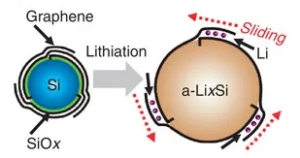Samsung claims to have made a breakthrough in battery power, using graphene and silicon. Graphene layers, added to a lithium-ion battery, are able to boost claimed performance by almost 100%, says the company.
A schematic illustration showing the sliding process of the graphene coating layers that can buffer the volume expansion of silicon.
Silicon has potential for use in batteries thanks to its high gravimetric capacity (capacity according to weight). However, a major issue limiting its use is that the material contracts and expands with each charge cycle, by as much as 300%. This introduces cracks that reduce performance and can cause short circuits.
Samsung has developed a way to grow graphene layers directly over the silicon nanoparticles, without forming silicon carbide. These graphene layers accommodate silicon’s volume expansion via a sliding process between adjacent layers.
When paired with a commercial lithium cobalt oxide cathode, the coating enables the full cell to reach volumetric (capacity according to size) energy densities of 972Whl-1 at the first charging cycle, and 700Whl-1 at the 200th. These are respectively 1.8 and 1.5 times higher than current commercial lithium-ion batteries.
Is it thought that 2D layered graphene structures, and its silicon carbide-free integration with silicon, can serve as a prototype in advancing silicon anodes to become commercially viable.
The research was published in the journal Nature, and can be found at http://tinyurl.com/prd3ab5.

